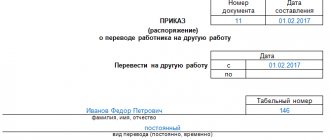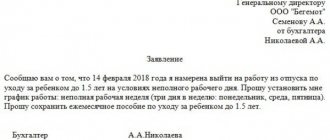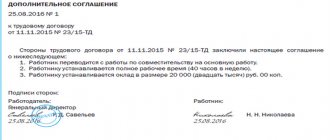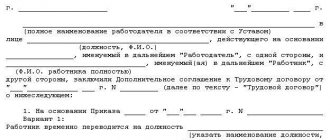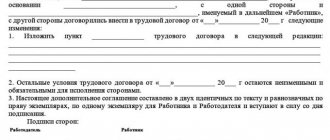Home » Human Resources Department » A maternity leaver wants to transfer to another organization. How to apply?
There are often cases now when pregnant women find employment not in order to work and build a career, but in order to be registered, receive maternity leave and not lose seniority. But the child is growing up and it’s time to think about a career. Having found a suitable employer, a young mother, without waiting for the child’s third birthday, has the right to demand a transfer to another organization , and the personnel officer is obliged to formalize the procedure strictly according to the rules of the Labor Code, which we will now discuss.
Conditions for transferring to another organization
Article 72.1 of the Labor Code does not prohibit the transfer of employees to another employer, as long as the employee himself agrees to this . There are no explanations about pregnancy or maternity leave. But transfer under this article is possible only by dismissing the vacationer from her previous job and finding employment in a new place .
In this case, the dismissal is formalized in accordance with Article 84.1 of the Labor Code:
- a statement is written;
- an order is being prepared based on the application;
- the employee gets acquainted with the order in writing;
- a work book is drawn up and issued.
Attention! Important: the employee’s statement will not be about dismissal, but about transfer to another company!
https://youtu.be/CHso63xJ_P0
If a woman does not give her consent
It is not uncommon for a woman on maternity leave to agree over the phone to be transferred to another position, but when it comes to documenting this process, she refuses. This is completely legal. The employee has the right to change her mind about working in a new department.
It is impossible to unilaterally change the terms of an employment contract. If a subordinate does not give her consent to the transfer, then the company management has no right to force her.
The administration of the enterprise is obliged to provide the woman with the opportunity to work in her previous place. In accordance with current labor legislation, the maternity position is not reduced. The only exception is the liquidation of the entire structural unit in which the employee works.
Expert opinion
Irina Vasilyeva
Civil law expert
In accordance with Article No. 72.1 of the Labor Code of the Russian Federation, the employee’s consent to the transfer is not required if the transfer is carried out without changing the terms of the concluded employment contract. For example, a subordinate continues to work with the same employer, in the same area and in the same position, but in a different structural unit.
Application for transfer to another organization
A sample application can be viewed here . There is no unified application form, but the required inclusions must be:
- Full name and position of the employee;
- date of transfer;
- where to transfer and to what position.
Attention! Nuance: warn the employee that if she does not find a new job within a month from the date of dismissal, the new employer has the right to refuse her employment under Article 64 of the Labor Code.
There is no probationary period for transfer.
Employee selection
Therefore, the employee has a choice: refuse the transition and continue working at his main place of work, or agree to sign an agreement with the management of the company.
We invite you to familiarize yourself with: Applications to defer the execution of a court decision
Separately, it is worth saying that before signing the agreement, you must carefully read it and clarify with the employer what exactly is meant by translation. Thus, unscrupulous employers may add the duties of a maternity worker to the duties of a deputy. As a result, it turns out that the employee does the work for two people, but continues to receive payment as a worker at his main workplace. It is also worth paying attention to the amount of additional payments when combining positions.
Translation nuances
When dismissing a mother caring for a child as a transfer, you need to take into account the following points:
Important points! Be sure to take it into account!
- dismissal occurs only on the initiative of a maternity leaver; dismissal at the whim of the employer is out of the question (Article 261 of the Labor Code). In this case, dismissal occurs under paragraph 5 of the first part of Article 77 of Article of the Labor Code;
- A mother cannot be recalled from leave to care for a child under three years old, even to process a transfer. You can draw up documents without an official call - by inviting a maternity leave person to the HR department on a specific day or by arranging for a meeting at her home;
- before starting the registration, you must have in your hands a written application from the employee for her dismissal in the order of transfer (it was discussed above);
- at the time of dismissal, maternity leave at the previous job is terminated; in order to continue receiving benefits, the mother must write an application to receive it from the new employer.
Features of transferring a maternity leaver to another position within the company
This procedure is provided for in Articles 72 and 72.1 of the Labor Code of the Russian Federation. Documentary registration of the transfer If the initiator of the transfer is an employee, he writes an application for the transfer.
If the administration of the organization, you need to obtain the employee’s written consent to the transfer. In practice, consent is most often formalized as follows.
The employee writes on the transfer order: “I agree to the transfer.” At the same time, the employee must be notified before issuing the order (Art.
72 and 73 of the Labor Code of the Russian Federation). There is no unified form of notification, so the organization can issue it in any form. On it, the employee must express in writing his consent or disagreement with the transfer.
The basis for dismissal is clause 8 of part 1 of article 77 of the Labor Code of the Russian Federation. Dismissal on this basis is aimed at protecting the health of the employee and is not considered a violation of his rights (decision of the Constitutional Court of the Russian Federation dated July 14, 2011 No. 887-
Important
O-O). A special procedure for dismissal in case of refusal of a vacancy (absence of vacancies in the organization) upon transfer for medical reasons is provided for managers, their deputies and chief accountants in Part 4 of Article 73 of the Labor Code of the Russian Federation. Even if the transfer period is less than four months, the organization has the right to dismiss such employees under clause 8 of part 1 of Article 77 of the Labor Code of the Russian Federation.
However, with the written consent of the employee, the employment contract with him can not be terminated, but he can be suspended from work for a period determined by agreement of the parties.
Info
In addition, the team has not changed, there is no need to delve into the affairs and documents of the enterprise, and there is no need to undergo adaptation or a probationary period. After 1-1.5 years, the cashier returned from maternity leave and the accountant was again transferred to his previous place of work.
What happened during this time? The legislation in the accounting field has changed, the company has expanded, but the returning accountant has to learn everything almost from the beginning. Skills and knowledge need to be restored. As a result, instead of an accountant-cashier, the employer receives only an employee who needs to improve the level of his qualifications while working in another position.
It should also be noted that the experience acquired while working on maternity leave is quite difficult to confirm. This is especially important if the temporary position was of a higher level (head of department, chief accountant, and so on).
The application of Article 74 of the Labor Code of the Russian Federation can have many nuances, and therefore, based on the content of your question, it is difficult to unambiguously answer the question of whether, in the situation you described, the employer has the right to apply this article to you. However, it is clear that in this case the new position offered to you cannot change the content of the job function you previously performed, i.e.
Your job responsibilities. In this case, the employer can change everything else, including the name of the position and the amount of earnings. Therefore, in this situation, you need to request from the employer the job description of the chief cashier approved by him and compare it with the job description of the leading cashier.
If the content of the job responsibilities of both positions differs, you will have the right to refuse the transfer offered to you, and in this case the employer will not be able to fire you under clause 7 of Art. 77 of the Labor Code of the Russian Federation. Rules approved by Decree of the Government of the Russian Federation dated April 16, 2003 No. 225, instructions approved by Decree of the State Statistics Committee of Russia dated January 5, 2004 No. 1).
When an employee is transferred for medical reasons, the new job may be either higher paid or lower paid. If an employee is transferred to a lower-paid job, then for a month from the date of transfer he must retain his average earnings from his previous job. If the transfer is due to the fact that the employee has suffered injury or an occupational disease, then the average salary is retained until the employee recovers or doctors determine his disability.
This procedure is established in Article 182 of the Labor Code of the Russian Federation. A situation may arise when an employee who needs a temporary transfer for medical reasons refuses it or there are no suitable vacancies in the organization.
Attention
The transfer of a maternity leaver to another position is carried out in the manner specified in Article 72 of the Labor Code of the Russian Federation, which specifies the general provisions for the transfer of employees. There is no specific mention of transfer on maternity leave to another position in the Labor Code of the Russian Federation, so the procedure is no different from the usual transfer of an employee, with one caveat that women caring for a child are usually transferred to another position only for the duration of maternity leave.
We invite you to read: Wages not paid upon dismissal: where to go, what to do in case of non-payment?
First of all, to transfer an employee to maternity leave, you need to obtain his written permission, for which you need to draw up an additional agreement to the employment contract, which must indicate the following information:
- Full name of the employee and name of the organization.
- The employee's current position and transfer details.
- The conditions under which the transfer is made (whether the employee has the right to return to work at any time at will to his previous position or will have a different position upon returning from maternity leave).
- Duration of the agreement (fixed-term or indefinite, if the employee is not planned to be transferred to his previous position upon return from maternity leave).
The employee must read the text of the document and certify it with a personal signature, after which an order can be issued to transfer to another position.
In any case, a pregnant employee has the right to terminate the employment contract by agreement of the parties (Clause 1, Part 1, Article 77 of the Labor Code), on her initiative (Clause 3, Part 1, Art.
77 of the Labor Code), in connection with a transfer to work for another employer (Clause 5 of Part 1 of Article 77 of the Labor Code), a pregnant woman can also be fired for circumstances beyond the control of the parties (Art.
83 Labor Code). Details in the System materials:
- Answer: How to transfer an employee to permanent work within the same organization
Types of transfers The Labor Code of the Russian Federation provides for two types of transfers to another job: temporary and permanent (Articles 72.1, 72.2 of the Labor Code of the Russian Federation). Types of Permanent Transfer In a permanent transfer, an employee may be transferred: The reasons for transfer to a new job in the same organization may vary.
Duration of maternity leave According to labor laws, a worker is entitled to 20 weeks if one child is born with one child. If there is more than one child at birth, this measurement is increased accordingly.
Provisions have also been introduced to allow employees to take so-called 26 weeks of parental leave immediately after maternity leave. Its size does not depend on the number of children born with one child.
The legislator extended the duration of the child's parental period, but also contributed to his long absence from work and thus reduced his usefulness in the performance of his duties.
Attention
What is your mom doing? “Nothing, but I’m often tired.” This is the second time, only for free - say women who are raising children. Caring for household responsibilities is reflected in their later retirement - in the fall of life, ladies receive the average ¾ of what gentlemen do.
The system needs to change so that older women are not dependent on their husbands. Changes for Pregnant Women Employed by Temporary Employment Agencies If the legislation comes into effect as proposed, it will mean significant changes for women employed by temporary employment agencies.
In the light of the current rules, Art. 177 § 3 of the Labor Code. And he says that “a contract of employment concluded for a fixed period or a probationary period of more than one month, which will be terminated after the third month of pregnancy, is extended until the day of delivery.”
The reason for refusal to submit an application must be communicated in writing to the employee. These rules include not only the grounds for entitlement to such leave, but also ensure that the employee returns to work after a long absence due to personal care.
Staying at home for such a long period of time may make it difficult for a skilled worker to return to work due to the organizational changes that will be occurring in the workplace at that time. Thus, the parent's return to the company may not be easy for both the employee and the employer.
Return to previous position Transfer during maternity leave involves different options for the employee to return to his place of work. And each of them has a different design. Basically, a regressive transition requires only the expression of the will of the parties.
Thus, no matter who initiates the transfer, the consent of the other party is important in any case. Just as an employer is not obligated to comply with an employee's request for a transfer, an employee is not obligated to agree to a transfer offered by the employer.
You will learn more about maternity leave and fixed-term employment contracts if you go to the material. Documentation What documents need to be completed when transferring an employee within the same organization? If the transfer is initiated by an employee, he writes a transfer application.
If the administration of the organization, you need to obtain the employee’s written consent to the transfer. In practice, consent is most often formalized as follows.
The employee writes on the transfer order: “I agree to the transfer.” At the same time, the employee must be notified before issuing the order (Art.
72 and 73 of the Labor Code of the Russian Federation).
To make changes to the employment contract, an additional agreement was drawn up. Based on the additional agreement, a transfer order was issued in the unified form No. T-5. An entry about the transfer to another position was made in the employee’s work book and personal card.
Transfer during vacation Question from practice: is it possible to transfer an employee to another position during his vacation: annual, without pay, educational? It is possible, but only with the employee’s consent to such a transfer. A transfer is permitted with the written consent of the employee, except in cases where such consent is not required (Article 72.1 of the Labor Code of the Russian Federation).
How to make a transfer
So, the transfer application is in your hands. Now you need to make sure that the state of health allows the maternity leaver to work in a new place, otherwise you risk violating Article 72.1 of the Labor Code (prohibition of transfer to a job contraindicated for health reasons).
Since the Labor Code ties your hands by prohibiting you from requiring a certificate about whether the employee’s health is suitable for her new job, and at the same time transfer to an unsuitable position is prohibited, you can demand a guarantee of employment from the new employer .
As a guarantee, this can be an invitation, issued arbitrarily and certified by the seal of the receiving company . Moreover, Article 64 of the Labor Code directly states that an invitation to work with a new employer must be in writing.
The text of the invitation is arbitrary, for example, this: “Solnyshko LLC is ready to accept A.A. Bochkarev as a translation. for the position of lawyer from Fortuna LLC.” In this case, the letter can be written on company letterhead, it is addressed to the head of the employee’s company, and is endorsed by the head of the receiving company.
It is not prohibited to draw up an agreement between companies on the transfer of a female employee . The agreement states:
- who dismisses the employee in the order of transfer and from what date;
- and who hires her (also indicating the date).
Reminder A proposal or agreement must be accompanied by a dismissal order!
After this, we fill out the T-8 order according to this example , introduce the maternity leave person to it and fill out the labor document.
Paperwork
Transfer to another position during maternity leave is quite common.
A temporary transfer to another job during maternity leave is formalized as follows.
- Initially, the employee is asked to sign an additional agreement to the current open-ended employment contract.
- Next, an order is issued to transfer the employee to another position. The order must be brought to the attention of the employee, he must read it and sign it.
- The HR department of the enterprise writes information about the transfer to another job in the employee’s personal card. The employee must also be familiarized with the rotation record against his personal signature.
Here is the procedure for completing documentation when replacing the main employee with a deputy. No entries are made in the work book or other documents of the company - vacation schedule, time sheet, etc.
Since the deputy main employee continues to be registered at his previous workplace, he will receive wages as usual. When signing documents for a woman on maternity leave, the deputy will sign as an acting employee.
Registration in labor transfer to another organization
Instructions for maintaining work records require that the grounds for dismissal be copied verbatim from the Labor Code article under which the employee is dismissed . In our case, we will copy paragraph 5 of paragraph 1 of part 77 of the article:
Text for labor “Dismissed by transfer to Solnyshko LLC with the consent (or at the request) of the employee, the fifth paragraph of the first part of Article 77 of the Labor Code of the Russian Federation.”
Don’t forget to fill out a T-2 card and a settlement note . Transfer to another organization has been completed!
how to fill out a T-2 card
Pros and cons of jumping between jobs
Transferring during maternity leave has both its advantages and disadvantages. Let's look at a specific example.
An accounting department employee was transferred during the cashier's maternity leave. Since in both cases the work is related to cash flow and registration, the company’s management considered that there was no need to hire a new employee. In addition, the team has not changed, there is no need to delve into the affairs and documents of the enterprise, and there is no need to undergo adaptation or a probationary period.
After 1-1.5 years, the cashier returned from maternity leave and the accountant was again transferred to his previous place of work. What happened during this time? The legislation in the accounting field has changed, the company has expanded, but the returning accountant has to learn everything almost from the beginning. Skills and knowledge need to be restored.
It should also be noted that the experience acquired while working on maternity leave is quite difficult to confirm. This is especially important if the temporary position was of a higher level (head of department, chief accountant, and so on). Therefore, in such cases, you should save all copies of additional agreements and request copies of transfer orders.
Transfer of the main employee to the place of a maternity leaver
Rules for maintaining and storing work books, preparing work book forms and providing employers with them; the work book contains information about the employee, the work he performs, transfer to another permanent job and the employee’s dismissal, as well as the grounds for termination of the employment contract and information about rewards for success in work. Temporary transfers are not mentioned in this list. In the company’s documents (vacation schedule, time sheet, etc.), the temporarily transferred employee will be listed in his previous position, because the transfer is not permanent, and the position of “maternity leaver” is not vacant so that another employee can begin to be registered in it .
Transferring an employee on maternity leave to another position - you need to know this
How often an employer has to deal with such a situation is known only to himself, as well as to the personnel employee. However, the employee should not relax and remain idle.
After all, as a rule, an entry in the work book about a transfer to another position during maternity leave is entered in connection with a temporary transfer, and it, in turn, has several specific features, for example:
- wage}
- professional experience}
- qualification category of the employee, etc.
Quite often, managers turn to specialists for help because they do not know whether the temporary transfer of another employee of the organization to the position of an employee who has gone on maternity leave is allowed. And just as often they receive a negative answer.
However, in some cases this is still possible. For example, if another employee, having familiarized himself with the responsibilities of the main employee, thinks everything over and decides to agree to the transfer. Just in case, the legislation provides for most of the circumstances in connection with which another employee has the right to refuse to move to another workplace.
When the time comes for the main employee to leave, personnel officers create an order to remove all functions and responsibilities of the main employee from the replacement employee, as well as transfer him to his old workplace in accordance with his previous position.
But before you start processing and make an entry in the work book about the transfer during maternity leave, you must receive a written application from the main employee.
This also happens: a woman reports that she wants to extend the period of maternity leave. Then the administration of the organization must draw up an additional agreement, but for a different period of validity.
Maternity leave is ensuring the right of pregnant women and women with children to work. A woman who is unable to work due to pregnancy and childbirth is not fired, but her job is retained.
A distinction should be made between maternity leave and parental leave until the child reaches 3 years of age. There is nothing complicated about applying for maternity leave.
The transfer of employees is carried out quite often and is done as follows:
- To begin with, an additional agreement to the employment contract is drawn up between the employee and the manager, then it is certified by the signatures of both parties. Please note: the document must contain information that the transfer is temporary.
- After which the employer must issue a special order in connection with the transfer of the employee to another position, and it must be presented to the employee for review and signature. It should also be mentioned that the transfer is temporary.
- Next, personnel workers enter the relevant information into the specialist’s personal card and also introduce him to the document for signature.
We suggest you familiarize yourself with Apartment redevelopment, what is possible and what is not
Both the expectant mother and the employer should remember that if an entry is made in the work book about a transfer during maternity leave, then the former’s wages should not change.
The documents should not contain any other information, namely, neither the employee’s vacation schedule, nor a time sheet related to working hours, etc.
As for the question of whether the relevant information should be entered into the work book, the answer will be no, it should not.
The only exception is if, at the end of the maternity leave, the employee decides to quit, the employer has the right to transfer the employee who replaced the maternity leave to a permanent position.
Only then does the personnel employee have the opportunity to enter the relevant information into the work book of the new permanent employee. This is done as follows:
- in the first column the entry number is entered in order}
- In the second column, the personnel employee enters the date of the actual transfer of the employee to the main place of work}
- the information itself is entered in the third column}
- the fourth contains information based on the issued transfer order.
Often employers and employees are not aware of whether an entry is made in the work book for an employee transferred to a position during the period of maternity leave of another employee. They can find the answer to their question in the rules and instructions, which set out a clear procedure for entering all the necessary information related to:
- with the employee's identity}
- with the nature of his professional activity}
- with transfers from one workplace to another}
- with employee reduction}
- with incentives and awards}
- as well as all information that has reasonable grounds for the employment contract to be terminated.
Information about various types of penalties, with the exception of disciplinary ones, in accordance with Art. 66 of the Labor Code of the Russian Federation are not included in the document.
As mentioned earlier, if the main employee, after the end of maternity leave, decided to quit and terminate the employment contract with the organization, a replacement employee can be hired in his place. In this way, it will no longer be just a transfer on a temporary basis, but a transition to permanent work.
Despite the fact that the rules do not allow making entries related to transitions on a temporary basis, sometimes personnel employees still make concessions and note everything necessary in their work books. This happens most often for reasons when such information is important in the employee’s career. By meeting the employee halfway, the organization risks quite a lot.
Both the employee and the employer can equally initiate a transfer to another workplace, not only temporary, but also permanent. The main difference is the registration process itself.
As for the reasons that guide an employee when deciding to move to another job, there can be a huge number of them. Most often this is a move, the appearance of a vacant and interesting place in the organization.
To begin with, the employee must submit a written application to the manager, which will include a request for transfer. It is best to use a stencil form, if available. In case of his absence, the employee will have to write a statement in any form. The content should include the following details:
- name of the document to be filled out}
- actual date of writing}
- registration number}
- details of the head of the organization}
- details of the author of the application}
- main text}
- confirmation signature.
In addition, the employee will be required to provide a written statement of the reasons and motives according to which he expressed a desire to move from one place to another.
We suggest you read: Is it possible to repay a loan in large amounts?
Afterwards, the employer communicates its decision by drawing up a resolution. Even if she was approving, the employee cannot be transferred. First, you should create an additional agreement between the parties. And only after this the manager is obliged to issue an appropriate order or a specific order on the transfer of the employee.
Once all documents have been completed, copies should be made and handed to the applicant. But an entry in the work book about a transfer to another position during the maternity leave of another employee should not be made, this is a violation of the rules.
Today, many employers are faced with the need to transfer an employee to another job. There may be several reasons for this, but the most common is the presence of a vacancy. This may be due to either sudden emergencies or a simple lack of personnel.
The transfer can only be carried out by mutual agreement of the parties. But there are exceptions: cases provided for in Art. 72 and 74 of the Labor Code of the Russian Federation, when the employer has the right to transfer an employee without his consent, but to a workplace that is not considered dangerous and is not contraindicated.
First of all, the manager is obliged to draw up either a written representation about the transfer or a special memorandum. These documents indicate:
- details of the employee who is being transferred}
- description of his professional qualities}
- professional experience in this organization}
- reasons for transfer.
Afterwards a resolution is drawn up. If approved by the manager, a corresponding proposal is created to the employee in writing. The employee then submits consent in the form of a separate document, for example, an application, which must be confirmed by his signature and date. Finally, an additional agreement is created between the parties to the contract.
Temporary transfer to another position during maternity leave has its own characteristics. They relate to remuneration, length of service, qualifications and other issues. Let's take a closer look at these features.
The law also defines situations in which a temporary transfer is valid.
Attention! These include the following:
- an agreement between an employee and an employer who employs a person for a precisely agreed period of time, after which the employee must return to his previous place of employment,
- replacing an employee who is temporarily absent from work, if such employee has the right to retain his position,
- force majeure and emergency situations forcing the person to be transferred to another job to eliminate the consequences of such problems, or ensuring the person’s employment during the period of elimination of the problem,
- a change in the employee’s health status that does not allow him to previously hold a specific position.
https://youtu.be/RZb4OzCMMqQ
An example of such a translation is the employment of a pregnant woman. For example, due to the special situation for a female employee, the production rate must be reduced, but after the birth of a child, the woman can begin full-time duties, that is, return to her previous work schedule.
Is leave allowed after maternity leave?
Do I have to sign anything else if I write a transfer application? 2. In fact, you will need to formalize your exit from care leave for 1 day, on the same day - transfer to a new one, and the next day - care leave again.
4. As I already wrote: an additional agreement to the employment contract, a transfer order, an entry in the T-2 personal card (it’s just your signature), and it is very advisable to see, read and sign the job description for the new one in advance.
The transfer of a pregnant woman to another job due to health conditions involves filling the position with a new employee hired on a temporary basis, which is indicated in the contract.
Everything about a maternity position - reduction, transfer and going on maternity leave
But in this case, this condition was agreed upon by the parties in writing, and changing it unilaterally is unlikely to be legal. In this case, the consent of the temporarily transferred employee is mandatory. We believe that a way out of this situation would be to fix the corresponding condition in an additional agreement. For example: “A temporary transfer may be terminated due to the following circumstance: the Employer’s hiring of another person for the position of the temporarily absent Elena Ivanovna Sidorova under the terms of a fixed-term employment contract...” Suppose that the employee expressed a desire to return “early” to his previous position, since the managerial position and working under irregular working hours do not serve his interests and negatively affect his family responsibilities.
It is clear that he cannot do this unilaterally.
Under the amendment, this will also be possible after a shorter period of maternity leave after childbirth. According to the amendment regulations, if the employee - the mother of the child is judged to be incapable of independent existence, the use of at least 8 weeks of maternity leave may cancel the remainder of the leave, provided that: - the remainder of the leave will be used by the employee - the father raising the child or the employee - another member of the immediate family - the period corresponding to the remainder of the use of maternity leave for personal care of the child will be carried out by the insured - the insured or the father of the child - another member of the immediate family, who, for the purpose of caring for the interrupted profitable activity. An accounting department employee was transferred during the cashier's maternity leave.
We hire you during maternity leave
The only exception is if, at the end of the maternity leave, the employee decides to quit, the employer has the right to transfer the employee who replaced the maternity leave to a permanent position. Only then does the personnel employee have the opportunity to enter the relevant information into the work book of the new permanent employee. This is done as follows:
- in the first column the entry number is entered in order}
- In the second column, the personnel employee enters the date of the actual transfer of the employee to the main place of work}
- the information itself is entered in the third column}
- the fourth contains information based on the issued transfer order.
Often employers and employees are not aware of whether an entry is made in the work book for an employee transferred to a position during the period of maternity leave of another employee.

